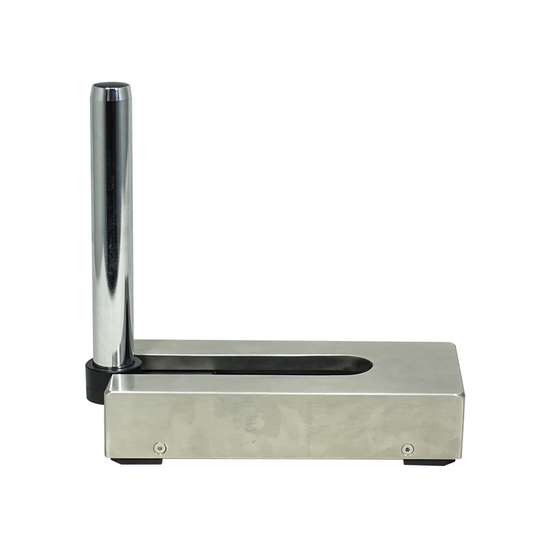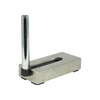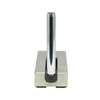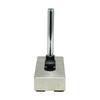Quick Overview
Gliding Base Stand. Vertical Post Height: 225mm. Vertical Post Diameter: Dia. 32mm. Base Dimensions: 125x275x55mm. Focusing Distance on Horizontal Direction: 190mm. ESD Safe.
ST19011401 Gliding Base Stand
Post Stand
| Stand Type | Gliding Base Stand |
| Vertical Post Height | 225mm |
| Vertical Post Diameter | Dia. 32mm |
| Base Type | Table Base |
| Base Shape | Rectangle |
| Base Dimensions | 125x275x55mm |
| Focusing Distance on Horizontal Direction | 190mm |
| Focus Mode | Manual |
| Surface Treatment | Natural Oxidation |
| ESD Safe | ESD Safe |
| Material | Metal |
| Color | Silver |
| Net Weight | 6.50kg (14.33lbs) |
| Dimensions | 125x275x280mm (4.921x10.827x11.024 in. ) |
Technical Info
Instructions
Microscope StandClose Λ
| Microscope stand have many options depending on the needs, especially stereo microscope stand, there are several factors to consider before choosing: Stability: microscope stand is used to prop up the microscope body. The stand should be selected according to the size of the microscope mainframe. The stability of the stand determines the stability of the microscope in use, and its various adapters and screws must be tightly locked. Volume size: limited by the working environment and space of the workbench. Workspace and scope: the size of the workspace of the object being observed and the height of the object being observed should be considered. Choice of lighting: some stands are equipped with a light source, but some are not, depending on whether there are conditions to add additional lighting. Operational requirements: 1. Install the stand as required. 2. Arrange a reasonable fixed position for the stand. 3. Carefully tighten the microscope mainframe. 4. Arrange the location of the additional light source reasonably, and place the electric wire in a position that does not interfere with the work. 5. Connect the various kinds of peripheral devices, such as cameras, monitors, computers and so on. |
Post StandClose Λ
| Post stand generally has relatively tall post. When the focus is adjusted, the focusing mechanism can slide up and down the post, the microscope is thus placed in an approximately focused position, and then the focusing mechanism makes fine and accurate adjustment. This kind of stand can move quickly, and is suitable for viewing objects with a higher height and bigger volume. After the microscope is mounted, the microscope imaging center needs to be aligned with the center of the platen. The focusing mechanism button on the post must be tightened to lock the guard ring device, and the microscope should be prevented from loosening and shaking when working. When it is necessary to adjust the height, hold the microscope and the focusing mechanism with one hand, then release the knob, adjust it to the proper position, lock the knob, then top the guard ring to the lower position of the focusing mechanism, and lock it tight. In particular, avoid accidental dropping of the microscope due to gravity, thereby damaging the microscope and the objects below. |
ESD SafeClose Λ
| Static electricity is a charge that is at static or non-flowing state, and static electricity is formed when charges accumulate on an object or surface. Static electricity can cause malfunction or mis-opeartion of electronic equipment, resulting in electromagnetic interference. In the electronics industry, static electricity can break down integrated circuits and precision electronic components, causing components to age, and can also absorb dust, causing contamination of integrated circuits and semiconductor components, and reducing production yield. In the plastics industry, static electricity can cause film or membrane not wining up uniformly, film and CD plastic discs contaminated with dust, thereby affecting quality. In industrial production, especially in electronic production and processing and inflammable and explosive production sites, electrostatic protection should be taken seriously. ESD means "electro-static discharge." For the methods of ESD treatment with respect to microscope and components, electrical conductivity of the metal should be utilized on the one hand, and on the other hand, electrostatic materials, electrostatic coating and other methods of treatment should be adopted to solve the electrostatic problem. Electrostatic coating is to apply coat that can prevent static electricity. It has electrostatic discharge, dust-proof, mildew-proof, wear-resistant, acid and alkali resistance and other characteristics. The surface of the coating does not generate static electricity or the static electricity is discharged to the safe place through the conductor row. On some components, electrostatic materials may be applied, such as the microscope knob handle, insulation mat, septum, microscope cover etc. |
PackagingClose Λ
| After unpacking, carefully inspect the various random accessories and parts in the package to avoid omissions. In order to save space and ensure safety of components, some components will be placed outside the inner packaging box, so be careful of their inspection. For special packaging, it is generally after opening the box, all packaging boxes, protective foam, plastic bags should be kept for a period of time. If there is a problem during the return period, you can return or exchange the original. After the return period (usually 10-30 days, according to the manufacturer’s Instruction of Terms of Service), these packaging boxes may be disposed of if there is no problem. |
| Packing | |
| Packaging Type | Carton Packaging |
| Packaging Material | Corrugated Carton |
| Packaging Dimensions(1) | 32.5x24x10.5cm (12.795x9.449x4.134″) |
| Inner Packing Material | Plastic Bag |
| Ancillary Packaging Materials | Expanded Polystyrene |
| Gross Weight | 6.80kg (14.99lbs) |
| Minimum Packaging Quantity | 1pc |
| Transportation Carton | Carton Packaging |
| Transportation Carton Material | Corrugated Carton |
| Transportation Carton Dimensions(1) | 32.5x24x10.5cm (12.795x9.449x4.134″) |
| Total Gross Weight of Transportation(kilogram) | 6.80 |
| Total Gross Weight of Transportation(pound) | 14.99 |

















